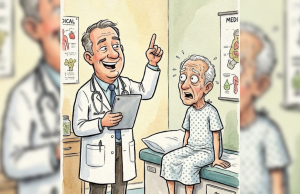
Could a seemingly simple dietary change be hiding a life-threatening illness? Camilla Chapman, an energetic 50-year-old mother, never expected that her minor swallowing troubles would uncover a devastating reality. Her experience serves as a critical reminder of how important it is to pay attention to our bodies, especially when something feels off.
Early Signs Brushed Off
Camilla’s story began in March 2024, when she decided to switch to a lighter, more liquid-based diet. Soon after, she started noticing occasional difficulty swallowing certain solid foods, like pancakes.
It seemed harmless, and she chalked it up to her new eating habits. At the time, she had no idea that these subtle changes were early red flags her body was trying to raise.
A Missed Opportunity
By June, Camilla noticed a small lump beneath her jaw. During a doctor’s visit, she casually mentioned it, but failed to bring up her ongoing swallowing issues.

Tests didn’t show anything worrisome, so she was sent home reassured. Believing it was just a passing issue, Camilla continued with life as usual, even as her symptoms gradually worsened.
Her difficulty swallowing became more frequent and noticeable, but she delayed returning to the doctor, thinking it would eventually resolve on its own.
A Harsh Diagnosis
It wasn’t until January 2025—almost a year after her first symptoms—that Camilla sought medical help again. This time, more comprehensive exams were conducted, including an endoscopy and biopsy.
The results came back in February and delivered a crushing blow: she had terminal stomach can.cer, already spread to her lungs, liver, and lymph nodes.
There was no option for a cure. Doctors offered palliative chemotherapy, intending to extend her life and ease her symptoms, not eradicating the disease.

A Powerful Message of Awareness
Rather than retreat into silence, Camilla chose to speak out. She wants her experience to serve as a wake-up call. “I didn’t have heartburn or anything dramatic—just trouble swallowing,” she said. “If only I had taken it seriously sooner.”
Her story highlights a crucial message: symptoms like trouble swallowing, stomach pain, or feeling full too quickly should never be dismissed. They may seem small, but they could point to something far more serious.
The Danger of Late Detection
Stomach can.cer is notoriously difficult to catch early. By the time symptoms become clear, the disease is often advanced. Early detection can lead to effective treatment and higher survival rates, but vague or mild symptoms make it easy to miss. Camilla’s case is a heartbreaking example of how important it is to act quickly when something feels wrong.

Signs of Stomach Can.cer
When a malignant lesion forms in the stomach, depending on the stage of the disease and the location of the lesion, the patient may have different signs. However, in general, this sign is often quite vague and not specific to the stomach can.cer (because this sign can also appear in other benign diseases of the stomach).
Symptoms of stomach can.cer include:
Early stages: Usually divided into 2 main groups:
- Gastrointestinal disorders: difficulty swallowing; belching, acid reflux, heartburn; nausea, vomiting.
- Pain sensation: dull, non-cyclical pain; pain when hungry; pain in the substernal area after a full meal.
Due to its non-specific and vague nature, this symptom is easily confused with a gastric ulcer. Therefore, patients are often subjective and do not screen for the disease early. This is also the reason why stomach can.cer is often detected late, when it is already in the advanced and metastatic stages.
Advanced stage: Signs of stomach can.cer are also divided into the following groups:
- Digestive disorders: nausea and vomiting; frequent heartburn; constant bloating; feeling full after eating little; loss of appetite.
- Pain sensation: often severe pain after eating or dull, irregular pain; pain when hungry; pain in the area below the sternum after eating.
- Bleeding in can.cerous lesions of the stomach: anemia, bloody or black stools, yellow skin.
- Nutritional disorders due to poor or no absorption: sudden weight loss, no known reason; dizziness, lightheadedness; fatigue to the point of reduced ability to work.

The Takeaway
Camilla’s journey teaches us that even mild or unusual symptoms should not be ignored. Listening to your body and seeking timely medical advice can make all the difference—sometimes, it can even save your life.
7 signs of late stage stomach can.cer

Stomach can.cer affects countless people around the world. The disease’s symptoms are frequently mistaken for those of other stomach disorders, leading to subjectivity. Can.cer is usually identified in its late stages, making treatment and care challenging. The following are seven indicators of stomach can.cer that no one should overlook.
1. Signs of late-stage stomach can.cer.
The disease progresses through four stages, each with its own set of symptoms and appearances. The following are the seven most immediately recognizable late-stage indications of stomach cancer:
Abdominal Pain
Abdominal discomfort is a common symptom in a variety of stomach-related medical disorders, including cancer. However, when a malignant tumor forms in the stomach, abdominal pain often manifests in unique ways. Typically, the pain is strong and frequent. The discomfort frequently develops in the epigastric region, especially when hungry or after meals, and does not go away even with pain relievers.
No appetite and a dread of eating.

Stomach cancer has a devastating effect on the digestive tract. Patients have difficulty eating due to dry mouth and nausea, and food is difficult to digest regularly, resulting in a loss of appetite. When using medicines that have side effects, the sense of loss of appetite is exacerbated.
Nausea and vomiting.
Nausea is one of the seven early signals of stomach can.cer, but it is commonly neglected because the symptoms are few and infrequent in the early stages. When the condition progresses, nausea and vomiting worsen due to the tumor pressing on the stomach, resulting in bloating and reflux. In addition, can.cer therapy medicines might produce nausea and vomiting.
Constipation and Diarrhea
The development of stomach cancer results in digestive difficulties and poor digestive function. This is the source of constipation in persons with stomach cancer. In addition, gut bacterial illnesses can cause people to have diarrhea. These are two typical symptoms that lead people to become fatigued and experience a prolonged loss of appetite.
Black stools.

Black stools are one of the seven immediately visible indicators of stomach can.cer in its late stages. The cause is the burst of some blood vessels on the tumor, or ulcerated tumor lesions in the stomach, which produce bleeding.
Lose weight quickly.
Most can.cer patients experience rapid weight loss. Stomach can.cer is one of the diseases that causes the most rapid weight loss because it affects the digestive tract. Cancer impairs the stomach’s capacity to digest food and absorb nutrients.
Pale skin with anemia
Frequent gastrointestinal bleeding causes patients to lose blood quickly, resulting in pale skin and a lack of vitality. Furthermore, because of the direct impact on the digestive tract, bad eating habits and the ability to absorb nutrients are not assured, thus the patient is constantly weary, skinny, and pale.
2. Early indications of stomach can.cer.

Most malignancies have vague initial signs. Cancer cells can only be found through examination and testing. As a result, when most cancer patients are diagnosed, they are already nearing the end of their disease. When it comes to stomach can.cer, you can seek for odd warning symptoms like:
- Frequent bloating, fullness, discomfort, nausea, and heartburn.
- Unexplained weight loss.
- Anorexia, epigastric discomfort, and gastroesophageal reflux.
- Difficulty swallowing and a sensation of something trapped in the throat.
If there are any unusual symptoms, the patient should see a doctor right once. The doctor will undertake examinations, stomach endoscopy, testing, and biopsies to determine the source of the sickness. From there, can.cer can be discovered early and treated appropriately.


















